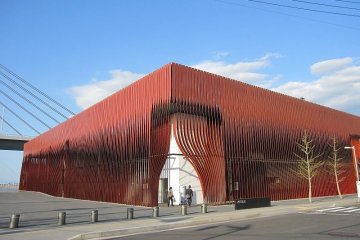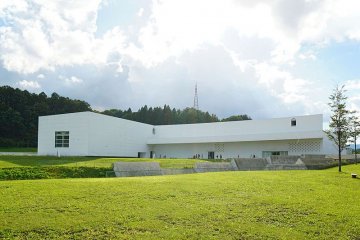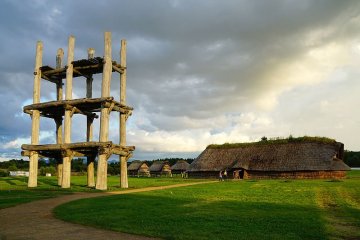
아오모리 A-Factory
Peter Sidell일본 아오모리 시 해안가에 있는 A-Factory는 사과 사이다, 주스, 해산물, 케이크, 그리고 다양한 종류의 맛있는 것을 파는 스탠드를 가지고 지역 생산 식품과 음료를 판매한다.

A-Factory in Aomori Prefecture is a premier duty-free marketplace that houses and sells various products, such as sweets, processed goods, fresh vegetables and fruits, and more wonders from all over Aomori, most notable are, of course, Aomori apples. Aomori remains the largest and most popular producer of apples in Japan.
Opened in late 2010, in conjunction with the extension of the Tohoku Shinkansen line to Aomori, the market is located on the Aomori Bay and makes for a striking outline against the Aomori bay Bridge. For tourists visiting the capital of the prefecture, A-Factory is an easy and convenient stop for specialty products.
As well as being a market for prefectural goods, the factory also serves as the brewery for an in-house apple cider that visitors can see being produced. By purchasing a tasting card, guests can even sample the freshly produced cider of A-Factory. In addition, there are several eateries and restaurants inside, ranging from burgers to apple fries.
All of the shopping and sampling and eating that awaits inside of A-Factory can also be enjoyed on the terrace or with a bay view from the large windows.
A one-minute walk from Aomori Station.

일본 아오모리 시 해안가에 있는 A-Factory는 사과 사이다, 주스, 해산물, 케이크, 그리고 다양한 종류의 맛있는 것을 파는 스탠드를 가지고 지역 생산 식품과 음료를 판매한다.

아오모리는 높은 품질의 해산물로 알려져 있다. 녹케동에는 본인 입맛에 맞는 해산물을 얹은 밥, 즉 돈부리를 만들 수 있는 작은 어시장이 있다.


네부타 박물관 와 랏세는 아오모리 역 주변 지역을 되살리기 위한 계획으로 2011년에 문을 열었습니다. 네부타의 역사, 사실, 그리고 부유물들이 광범위하게 전시되어 있는데, 매년 4개의 새로운 조형물들이 선택받아지고 오래된 조형물들은 점차 빠져나가는 방식으로 진행되고 있습니다. 아오모리 지역의 축제 참가 희망을 목표로 하는 와 랏세는 매년 아오모리 만 수변에서 열리는 네부타 축제에 집중되어 왔습니다. 이 박물관의 놀라운 외관은 아오모리 뿌리의 일부이기도 하는데, 많은 방문객들에게 빨간 리본처럼 보이는 것은 아오모리의 오래된 너도밤나무 숲을 통과하는 빛을 연상시키기 때문입니다. 이 흥미로운 외관은 박물관으로 흘러들어오는 자연광의 양을 줄이는 데도 도움이 됩니다. 방문객들은 2층에 있는 네부타 박물관 와 랏세 투어를 시작합니다. 마쓰리의 역사를 알게 되고 역사적인 사진에서 반짝반짝 빛나는 모습을 본 손님들은 주요 전시장이 내려다보이는 발코니로 안내됩니다. 희미한 불빛 속에서 실제 네부타 조형물들이 전시되는 곳이 바로 이곳에 있습니다. 다소 어두워진 방 덕분에, 조형물들은 야간 축제 동안 보유한 화려한 색깔들을 선보입니다. 그뿐만 아니라 인터랙티브 액티비티들과 하루에 세 번 진행되는 30분간의 긴 체험도 있습니다. 이 전시회에서 방문객들은 아오모리 네부타 축제에 실제로 참석하는 것이 어떤 것인지 맛볼 수 있습니다.

Since opening in July 2006, the Aomori Museum of Art has been active in having exhibitions, concerts, plays, and workshops by Aomori-native artists and performers. Most notably, Yoshitomo Nara, Shiko Munakata, Shuji Terayama, and Toru Narita are forerunners of the museum’s exhibits; with The Aomori Dog by Yoshitomo Nara being the museum’s symbol. The museum architecture itself is also an important part of the surrounding landscape and features as an exhibit itself. Designed by Jun Aoki to resembled the nearby Sannai Maruyama Historical Site excavation area, the simple walls and shape lend itself well to the beauty of the land. Atsuki Kikuchi, responsible for the visual identity of the building, decorated the exterior with stylized trees that represent the Aomori landscape and its connection to nature. With four floors of art to explore, the Aomori Museum of Art contains a theater, community gallery, restaurant, shop, and more in addition to its galleries. The galleries also contain artwork from international artists, such as Kandinsky, Klee, Matisse, Rembrandt, and Picasso. Visit this museum that brings nature and art together in a harmonious union.

The Sannai-Maruyama Site is a historically important archeological site and museum located in Aomori Prefecture. The ruins belonged to a large Jomon-period settlement and were originally rediscovered in 1992. The people of the Jomon age were known for their sedentary lifestyles and this settlement has provided artifacts as well as a look into the lives of the people of the past. Excavation of the site unearthed storage pits and above-ground storage further cementing the people as belonging to the region. The site has been designated a Special National Historical Site of Japan. Visitors may make their way to the site and see the reconstructions of Jomon-style architecture and artifacts native to the site. The Sanmaru Museum exhibits over 1700 artifacts and about 500 Important Cultural Properties that were all excavated from the Sannai-Maruyama site. Inside the museum, guests will be able to watch a video on the lifestyle of the Jomon people (with English audio devices available upon request). Alongside the artifacts from the Sannai-Maruyama site are figures that best represent how scientists believe the tools were used.